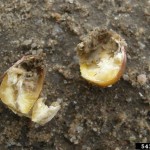Date: Thursday, June 18, 2015
Location: Integrity Propagation, Route 563, SpeedwellJust south of Chatsworth. Look for the Lee Brothers Ocean Spray sign and turn down the road right next to the sign. You will see the greenhouses about ¼ mile down the road on the right hand side.
All cranberry growers are invited to this growers twilight meeting hosted by Integrity Propagation-Abbott Lee and sponsored by Rutgers Cooperative Extension and the New Jersey Agricultural Experiment Station.Meeting Agenda
5:30 Dinner
6:00 Program begins. Topics of importance to cranberry growers in New Jersey: diseases, monitoring, management of fruit quality, weather forecasting equipment, insect control, new bed establishment, pesticide storage design, pesticide storage hazard assessment, and more.Pesticide Credits Awarded: total of 6 in 3 categories.
Cranberry Growers Twilight Meeting
Soil Temperatures and Seedlings
We recorded 56-58°F temperatures from soils in various Central Jersey commercial vegetable fields on April 15 –Tax Day– just before the recent multi-day cold front rolled in. The good news is 56-58°F was higher than I anticipated.
What do soil temperatures have to do with your early vegetable seedlings?
- Mean spring soil temperatures determine early root growth and crop development.
- By tracking spring soil temperatures from your fields you’ll become a more profitable farmer.
- Matching your earlier warming fields to tolerant seedlings of vegetables found in the table below is worthwhile.
Sweet Corn Insects: Underground & Unseen
Early season sweet corn damage from seedling insects is easily underestimated since it happens underground. By the time spotty, inconsistent stands or dying seedlings are observed, it is too late for control. Over the years, I’ve gathered tips especially applicable to the cold, wet spring we are experiencing:
- The cold weather is keeping soil temperature below the desired range for good germination. The longer seed remains in the ground before emerging, the more time seed is susceptible to seed corn maggots and wireworms. In addition, experts are warning us not to count on this winter’s brutal, low temperatures to reduce pests.
- Be wary of planting untreated seed. Using untreated seed in check rows in our Rutgers 2011 sweet corn trials resulted in pitiful 28% stands. Most sweet corn seed is now commercially treated before you receive it. Common treatments may include Cruiser, Gaucho, Poncho (these extend protection to early flea beetles), Lorsban or various other branded combination treatments. If your seed is untreated, you can use a hopper box treatment of Concur or Latitude or, at-planting soil-applied treatments with Counter to help suppress early pests. Consult page F178 in the 2014 Commercial Vegetable Recommendations.
Dig around some emerging sweet corn plants; you might be surprised at what you find!

